Presentation_Grau(Roche)_Miptec 2011_ ... - Cisbio Bioassays
Presentation_Grau(Roche)_Miptec 2011_ ... - Cisbio Bioassays
Presentation_Grau(Roche)_Miptec 2011_ ... - Cisbio Bioassays
You also want an ePaper? Increase the reach of your titles
YUMPU automatically turns print PDFs into web optimized ePapers that Google loves.
IgG core a-fucosylation and its impact on<br />
FcgRIIIa binding<br />
MipTec 21.09.<strong>2011</strong><br />
Sandra <strong>Grau</strong><br />
<strong>Roche</strong> Glycart AG
Introduction<br />
TagLite Results<br />
Outlook<br />
Sandra <strong>Grau</strong>, <strong>Roche</strong> Glycart AG<br />
2
Introduction<br />
Antibody therapies<br />
‣ Monoclonal antibodies represent a growing class of therapeutics with more<br />
than 20 molecules licenced for the treatment of cancer and chronic<br />
diseases.<br />
‣ Major indications: oncology, infectious diseases and autoimmunity.<br />
‣ Efficacy results from their specificity to the antigen target as well as the<br />
activation of effector functions.<br />
‣ In oncology one relevant mechanism of action is antibody-mediated cellular<br />
cytotoxicity (ADCC):<br />
• This was shown for various antibody therapeutics such as rituximab<br />
(anti-CD20) and trastuzumab (anti-Her2).<br />
• The mechanism underlying ADCC is the binding of FcgRIIIa on<br />
natural killer cells (NK cells) to the Fc portion of an IgG and killing<br />
of the target cell<br />
Sandra <strong>Grau</strong>, <strong>Roche</strong> Glycart AG<br />
3
Introduction<br />
Glycoengineering<br />
Main goal for next generation therapeutic antibodies was:<br />
Increase the binding of the antibody to activating FcgRs (FcgRIIIa).<br />
‣ Two different strategies:<br />
• Amino acid mutations in the Fc part of the antibody<br />
• Changing the carbohydrate moieties in the Fc portion of the antibody<br />
a-fucosylated antibodies show increased binding to FcgRIIIa and enhanced ADCC in<br />
vitro<br />
Carbohydrate component<br />
Constant region interacts with<br />
cells from the immune system<br />
Sandra <strong>Grau</strong>, <strong>Roche</strong> Glycart AG<br />
4
Introduction<br />
Glycoengineering<br />
‣ Glycosylation of IgGs<br />
9<br />
Galβ1<br />
8<br />
4GlcNAcβ1<br />
7<br />
2Manα1<br />
Fucα1<br />
Galβ1<br />
4GlcNAcβ1<br />
GlcNAcβ1<br />
2Manα1<br />
6<br />
4Manβ1<br />
3<br />
3<br />
4GlcNAcβ1<br />
2<br />
6<br />
4GlcNAc<br />
1<br />
Asn297<br />
6<br />
5<br />
4<br />
Removal of fucose increased affinity for FcgRIIIa<br />
How can one generate antibodies<br />
lacking the fucose?<br />
Picture taken from Claudia Ferrara, <strong>Roche</strong> Glycart AG<br />
5
Introduction<br />
Glycoengineering<br />
Engineering cell lines overexpressing GnTIII<br />
N-linked glycosylation<br />
high<br />
mannose<br />
GnT-III<br />
competes against<br />
a1,6-FuT<br />
bisected<br />
non-fucosylated<br />
GnT-I<br />
Asn<br />
ManII and GnT-II<br />
hybrid<br />
ManII<br />
GnT-III<br />
a1,6FuT<br />
bisected<br />
hybrid<br />
GnT-II<br />
a1,6FuT<br />
complex<br />
GnT-III<br />
a1,6FuT<br />
Asn<br />
bisected<br />
complex<br />
Why has the presence of the fucose<br />
such a great impact on binding?<br />
N-acetylglucosamine (GlcNAc)<br />
Mannose<br />
Fucose<br />
Picture taken from Claudia Ferrara, <strong>Roche</strong> Glycart AG<br />
6
Introduction<br />
Crystal structure of FcgRIIIa complexed with either a-<br />
fucosylated or fucosylated Fc<br />
FcgRIIIa / a-fuc Fc<br />
‣ Carbohydrate-carbohydrate<br />
mediated interactions are<br />
responsible for an up to<br />
100-fold gain in binding<br />
FcgRIIIa / fuc Fc<br />
affinity for a-fucosylated vs.<br />
fucosylated IgGs.<br />
* Ferrara et al., PNAS, August 2, <strong>2011</strong>, vol. 108, no. 31, 12671<br />
7
Introduction<br />
Crystal structure of FcgRIIIa complexed with either a-<br />
fucosylated or fucosylated Fc<br />
‣ The Fc-core fucose (highlighted in yellow) has to accomodate in the interface and the Asn162-receptor<br />
glycan has to move ( ).<br />
‣ The result is a direct, steric inhibition caused by core fucose for the carbohydrate-mediated interaction<br />
with FcgRIIIa.<br />
‣ The structures provide a molecular mechanism explaining the increased affinity for the receptor of a-<br />
fucosylated antibodies.<br />
* Ferrara et al., PNAS, August 2, <strong>2011</strong>, vol. 108, no. 31, 12671<br />
8
Introduction<br />
Characterization of monoclonal IgGs<br />
Carbohydrate analysis<br />
Biological actitivity<br />
High throughput<br />
ProtA purification<br />
ADCC<br />
Affinities<br />
Endoglycosidase<br />
digest<br />
Surface Plasmon<br />
Resonance<br />
MALDI TOF MS<br />
analysis<br />
Could the TagLite technology combine<br />
some of these analysis?<br />
Sandra <strong>Grau</strong>, <strong>Roche</strong> Glycart AG<br />
9
Introduction<br />
TagLite Results<br />
Outlook<br />
Sandra <strong>Grau</strong>, <strong>Roche</strong> Glycart AG<br />
10
TagLite – results<br />
FcgRIIIaV158 and F158 competition assay<br />
Tb<br />
FRET signal<br />
Tb<br />
Unlabeled IgGs with<br />
various a-fuc degree<br />
Human IgG-d2 low a-fuc<br />
Hek<br />
Hek<br />
Assay setup:<br />
•10.000 cells per well (expressing huFcgRIIIaV158 or F158 labeled with Tb)<br />
•IgGs with various a-fucosylation degrees (4, 8, 11, 57 and 80 %) conc. 4000 to 1.8 nM final in well (1:3<br />
dilutions).<br />
•Labeled IgGs (human IgG-d2); conc. 50 nM final in well<br />
•Incubation time: 0h, 1h, 3h, 5h @ RT<br />
Sandra <strong>Grau</strong>, <strong>Roche</strong> Glycart AG
TagLite – results<br />
FcgRIIIa(V158)<br />
‣ The assay works nicely with the high affinity receptor.<br />
‣ Already after one hour incubation ranking of the abs can be detected.<br />
‣ The 2 IgGs with high a-fuc degree compete much better than the 3 IgGs with lower a-fuc degree.<br />
Sandra <strong>Grau</strong>, <strong>Roche</strong> Glycart AG/ Delphine Jaga, <strong>Cisbio</strong> Bioassay
TagLite – results<br />
FcgRIIIa(F158)<br />
‣ The assay also works with the low affinity receptor but the assay window is much smaller.<br />
‣ Still also here the higher a-fucosylated IgGs compete better than the ones with lower a-fuc content.<br />
Sandra <strong>Grau</strong>, <strong>Roche</strong> Glycart AG/ Delphine Jaga, <strong>Cisbio</strong> Bioassay<br />
13
TagLite – results<br />
Comparison FcgRIIIa(V158) and FcgRIIIa(F158)<br />
Sandra <strong>Grau</strong>, <strong>Roche</strong> Glycart AG/ Delphine Jaga, <strong>Cisbio</strong> Bioassay<br />
14
a-fuc increase<br />
a-fuc increase<br />
TagLite – results<br />
Correlation with other methods<br />
Biacore binding curve – capture format<br />
huFcgRIIIaF158<br />
MALDI<br />
Biacore<br />
TagLite<br />
4 % a-fuc FcgRIIIaF158<br />
a-fuc (%) KD (nM) EC50 (nM)<br />
832 4 1300 881<br />
834 8 940 728<br />
835 11 845 170<br />
836 57 68 32<br />
842 80 39 27<br />
improved off rate<br />
80 % a-fuc FcgRIIIaF158<br />
improve in KD/EC50 improve in KD/EC50<br />
huFcgRIIIaV158<br />
MALDI<br />
Biacore<br />
TagLite<br />
a-fuc (%) KD (nM) EC50 (nM)<br />
832 4 200 555<br />
834 8 201 370<br />
835 11 111 226<br />
836 57 17 28<br />
842 80 7 13<br />
4 % a-fuc FcgRIIIaV158<br />
Note: KD values (Biacore) depend a lot on the format used.<br />
In the present format KD values for a-fuc abs tend to be lower<br />
than with other formats. You can expect values ranging from<br />
500-700 nM for FcgRIIIaV158 and low a-fuc abs.<br />
improved off rate<br />
80 % a-fuc FcgRIIIaV158<br />
Sandra <strong>Grau</strong>, <strong>Roche</strong> Glycart AG/ Delphine Jaga, <strong>Cisbio</strong> Bioassay<br />
15
TagLite – results<br />
Correlation with other methods<br />
Biological activity -<br />
BLT assay<br />
FcgRIIIaF158<br />
‣ The BLT assay measures the release of esterase upon activation of NK cells<br />
‣ The graph shows that the 2 IgGs containing higher a-fuc degree lead to a 3 fold higher release of<br />
esterase than the ones with lower a-fuc degree.<br />
‣ The release correlates well with killing of the target cell.<br />
Sylvia Herter, <strong>Roche</strong> Glycart AG<br />
16
Introduction<br />
TagLite Results<br />
Outlook<br />
Sandra <strong>Grau</strong>, <strong>Roche</strong> Glycart AG<br />
17
Conclusion/Outlook<br />
‣ The TagLite technology provides a nice, robust and easy to use tool to study binding of<br />
antibody Fc portions to FcgRIIIa on cells.<br />
‣ The data correlate well with data from Biacore and cell based assays like ADCC<br />
‣ An advantage compared to Biacore analysis is that binding occurs with native receptor<br />
embedded in the cell membrane rather than purified soluble forms which translates better<br />
into cell based assays.<br />
‣ Interesting would be to test also other hu Fcg receptors as well as muFcgR which might be<br />
of importance fo mouse models.<br />
‣ Also to be checked: Could you determine a-fucosylation degree simply by using a standard<br />
curve of IgGs with various a-fucosylation degree and therefore use the TagLite assay for<br />
screening purposes?<br />
Sandra <strong>Grau</strong>, <strong>Roche</strong> Glycart AG<br />
18
Acknowledgements<br />
<strong>Roche</strong> Glycart<br />
Pablo Umana<br />
Christiane Jaeger<br />
Claudia Ferrara<br />
Sylvia Herter<br />
<strong>Cisbio</strong> Bioassay<br />
Delphine Jaga<br />
Hamed Mokrane<br />
19
We Innovate Healthcare<br />
20


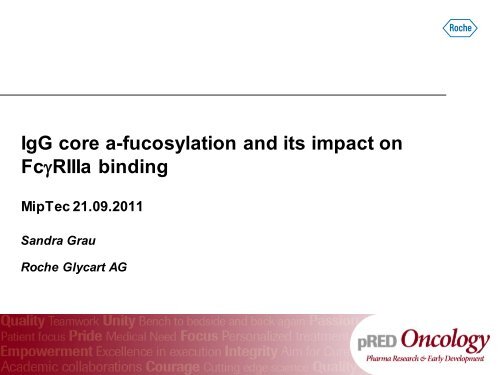
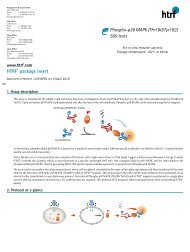

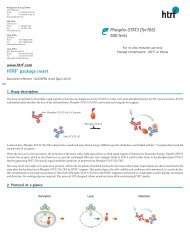
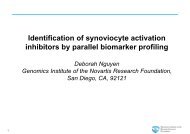
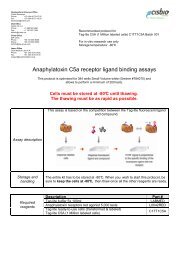
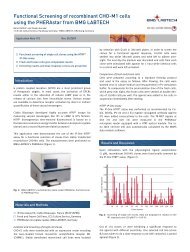
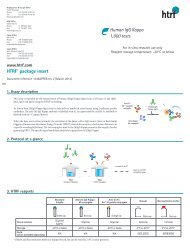
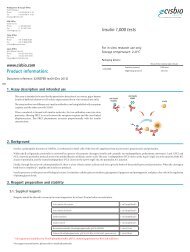

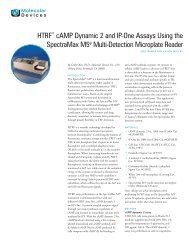
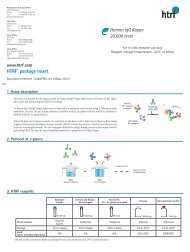
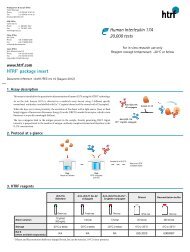

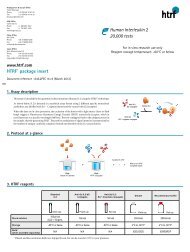
![HTRF meeting_130426_villa_pour pdf [Mode de compatibilité]](https://img.yumpu.com/22345646/1/190x135/htrf-meeting-130426-villa-pour-pdf-mode-de-compatibilitac.jpg?quality=85)